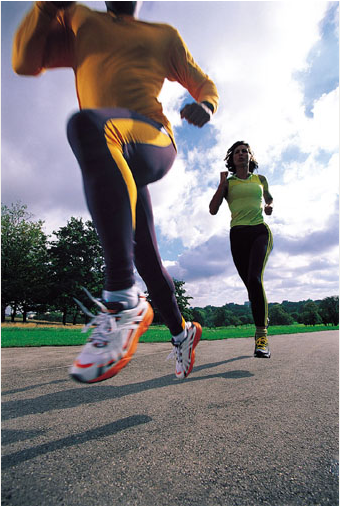 Finding the most comfortable athletic shoe can be a hassle for consumers who may not exercise regularly or are just beginning their regimen. Sorting through all the numerous claims from shoe brands can be overwhelming if one doesn’t really know what or how a shoe should feel.
Finding the most comfortable athletic shoe can be a hassle for consumers who may not exercise regularly or are just beginning their regimen. Sorting through all the numerous claims from shoe brands can be overwhelming if one doesn’t really know what or how a shoe should feel.
There are shoes that help runners absorb the impact from exercising on hard surfaces, as well countless shoes that help everyone from basketball enthusiasts to hikers. A large segment of the exercising public have fallen head over heels for “toning shoes.” With a pair of these shoes, manufactures promise that consumers, with the help of specially-shaped soles, will receive a boost in lean, toned muscle in their buttocks, thighs, and calves.
But, this is the same promise that almost all brands sale with celebrity-endorsed campaigns. Buy this and you’ll experience this; we all know the drill. It’s hard to figure out if the brand is telling the truth or just trying to sale the consumer another over-priced product.
In a New York Times consumer report, they found a doctor and shoe store owner who wanted to test and see if the claims of the latest toning shoes were valid. So Dr. John Mercer, a biomechanics professor at the University of Nevada, Las Vegas, put together a test group consisting of healthy young female students (toning shoes are marketed almost exclusively to women) and had them walk on a treadmill for 10 minutes at a time while wearing, alternately, a walking shoe or a toning shoe — in this case, the Skechers Shape-ups.
He and his colleagues attached sensors to the women’s legs to measure the electrical impulses generated as their muscles contracted. They also determined the women’s oxygen consumption, to see if they worked harder and burned more calories with one shoe rather than the other.
The results were provocative in that they proved that there was no difference between the regular walking shoes and toning shoes. Participants in the study remarked that toning shoes felt different under their bottoms, but as stated before, the finding shows that their was nothing special about the technology.
Coupled with other studies that have produced similar results, shoe companies seem to be selling empty promises, at least about “toning” shoes.
Here’s the gimmick: manufactures produce a shoe with an unstable sole, which forces the wearer to incorporate muscles not utilized with average exercise shoes. Thus, for a short period of time, the consumer feels a difference when they use their “new” muscles to stabilize themselves during working out.
By the time you figure out what has happened, your shoes are paid for and you, more than likely, if you worked out consistently, won’t care if you were duped or not.
Basically, it all comes down to the feel and look of the shoe, not the actual proposed benefits.






